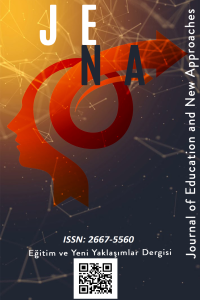Öz
Kaynakça
- Anderson, L. W., & Krathwohl, D. R. (2001). A taxonomy for learning, teaching, and assessing. Allyn and Bacon.
- Arslan, M. M., Mirici, İ. H., & Yaman, M. (2001). Millî Eğitimin yasal dayanağı mevzuat–I. Anıttepe.
- Braden, R. A. (1996). Visual literacy. In D. H. Jonassen (Ed.), Handbook of research for educational communications and technology. Simon & Schuster.
- Debes, J. L. (1968). Some foundations for visual literacy. Audiovisual Instruction, 13, 961-964.
- Glasgow, J. N. (1994). Teaching visual literacy for the 21st century. Journal of Reading, 37(6), 494–500.
- Kellner, D. (2001). New Technologies/new literacies: Reconstructing education for the millennium. International Journal of Technology and Design Education, 11, 67- 81.
- Lundy, A. D., & Stephens, A. E. (2015). Beyond the literal: Teaching visual literacy in the 21st century classroom. Procedia-Social and Behavioral Sciences, 174, 1057–1060.
- Merriam, S. B. (2013). Nitel araştırma-desen ve uygulama için bir rehber. (S. Turan, Trans). Nobel.
- Metros, S. E., & Woolsey, K. (2006). Visual literacy: An institutional imperative. Educause Review, 41(3), 80–81.
- Miles, B. M., & Huberman M. A. (2016). Nitel veri analizi (S. Akbaba Altun & A. Ersoy, Trans.). Pegem Akademi.
- MNE. (2009). İlköğretim Türkçe dersi öğretim programı ve kılavuzu (1-5. sınıflar). Devlet Kitapları.
- MNE. (2019). Türkçe dersi öğretim programı (ilkokul ve ortaokul 1, 2, 3, 4, 5, 6, 7 ve 8. sınıflar). https://mufredat.meb.gov.tr/ProgramDetay.aspx?PID=663
- Petterson, R. (1993). Visual information (2nd edition). Educational Technology Publication.
- Yıldırım, A., & Şimşek, H. (2016). Sosyal bilimlerde nitel araştırma. Seçkin.
- Yıldız, M. Ö. (2012). Görsel okuryazarlık üzerine. Marmara İletişim Dergisi, 19, 64-77.
Comparison of 2009 and 2019 Turkish Curriculum Objectives in Terms of Visual Reading and Visual Presentation Skills
Öz
Effective use of visuals, which is one of the important coding systems in terms of understanding and expression effectiveness, in the communication process is as important as the basic language skills of Turkish. For this reason, visuals are used in language education, and therefore in language teaching curriculums, students need to understand visuals accurately, quickly and completely and express themselves effectively with them. In other words, content to improve visual literacy skills should be included. Because in Turkish education, visuals serve to create meaning, support the meaning or accompany the meaning. In the Turkish Curriculum for Grades 1-5, which was prepared within the framework of a constructivist approach and started to be implemented in 2005 in order for students to acquire these skills, for the first time, a learning area called "Visual Reading and Visual Presentation" was included alongside the four basic language skills with 28 objectives. This practice, which was not found in the teaching programs for secondary school of that period or the primary and secondary school levels of the following years, is thought to be appropriate in terms of developing students' visual literacy skills. It is aimed to compare the achievements of the 2019 Turkish Course Curriculum, which was renewed and implemented in 2018 and took its final form in 2019 with the achievements of the 2009 Turkish Course Curriculum (Grades 1-5), which started to be implemented in 2005 and took its final form in 2009 with some changes, additions, deletions and corrections in the context of visual reading and visual presentation skills in this study. Document analysis technique was used in the study, which was conducted in accordance with the descriptive research model and qualitative research method. The examination objects of the study are the Turkish curriculums published by the Ministry of National Education, Board of Education in 2009 and 2019. In this context, objectives related to visual reading and visual presentation were identified in the curriculums; the data are presented in tables. At the end of the research, suggestions were presented for curriculum designers and researchers.
Anahtar Kelimeler
Visual reading visual presentation Turkish curriculum Turkish education
Kaynakça
- Anderson, L. W., & Krathwohl, D. R. (2001). A taxonomy for learning, teaching, and assessing. Allyn and Bacon.
- Arslan, M. M., Mirici, İ. H., & Yaman, M. (2001). Millî Eğitimin yasal dayanağı mevzuat–I. Anıttepe.
- Braden, R. A. (1996). Visual literacy. In D. H. Jonassen (Ed.), Handbook of research for educational communications and technology. Simon & Schuster.
- Debes, J. L. (1968). Some foundations for visual literacy. Audiovisual Instruction, 13, 961-964.
- Glasgow, J. N. (1994). Teaching visual literacy for the 21st century. Journal of Reading, 37(6), 494–500.
- Kellner, D. (2001). New Technologies/new literacies: Reconstructing education for the millennium. International Journal of Technology and Design Education, 11, 67- 81.
- Lundy, A. D., & Stephens, A. E. (2015). Beyond the literal: Teaching visual literacy in the 21st century classroom. Procedia-Social and Behavioral Sciences, 174, 1057–1060.
- Merriam, S. B. (2013). Nitel araştırma-desen ve uygulama için bir rehber. (S. Turan, Trans). Nobel.
- Metros, S. E., & Woolsey, K. (2006). Visual literacy: An institutional imperative. Educause Review, 41(3), 80–81.
- Miles, B. M., & Huberman M. A. (2016). Nitel veri analizi (S. Akbaba Altun & A. Ersoy, Trans.). Pegem Akademi.
- MNE. (2009). İlköğretim Türkçe dersi öğretim programı ve kılavuzu (1-5. sınıflar). Devlet Kitapları.
- MNE. (2019). Türkçe dersi öğretim programı (ilkokul ve ortaokul 1, 2, 3, 4, 5, 6, 7 ve 8. sınıflar). https://mufredat.meb.gov.tr/ProgramDetay.aspx?PID=663
- Petterson, R. (1993). Visual information (2nd edition). Educational Technology Publication.
- Yıldırım, A., & Şimşek, H. (2016). Sosyal bilimlerde nitel araştırma. Seçkin.
- Yıldız, M. Ö. (2012). Görsel okuryazarlık üzerine. Marmara İletişim Dergisi, 19, 64-77.
Ayrıntılar
| Birincil Dil | İngilizce |
|---|---|
| Konular | Türkçe Eğitimi |
| Bölüm | Makaleler |
| Yazarlar | |
| Yayımlanma Tarihi | 30 Aralık 2023 |
| Gönderilme Tarihi | 14 Aralık 2023 |
| Kabul Tarihi | 29 Aralık 2023 |
| Yayımlandığı Sayı | Yıl 2023 Cilt: 6 Sayı: 2 |

